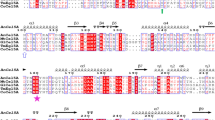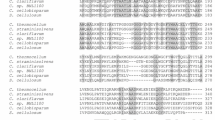Abstract
Family 48 glycoside hydrolases (cellobiohydrolases) are among the most important cellulase components for crystalline cellulose hydrolysis mediated by cellulolytic bacteria. Open reading frame (Cphy_3368) of Clostridium phytofermentans ISDg encodes a putative family 48 glycoside hydrolase (CpCel48) with a family 3 cellulose-binding module. CpCel48 was successfully expressed as two soluble intracellular forms with or without a C-terminal His-tag in Escherichia coli and as a secretory active form in Bacillus subtilis. It was found that calcium ion enhanced activity and thermostability of the enzyme. CpCel48 had high activities of 15.1 U μmol−1 on Avicel and 35.9 U μmol−1 on regenerated amorphous cellulose (RAC) with cellobiose as a main product and cellotriose and cellotetraose as by-products. By contrast, it had very weak activities on soluble cellulose derivatives (e.g., carboxymethyl cellulose (CMC)) and did not significantly decrease the viscosity of the CMC solution. Cellotetraose was the smallest oligosaccharide substrate for CpCel48. Since processivity is a key characteristic for cellobiohydrolases, the new initial false/right attack model was developed for estimation of processivity by considering the enzyme's substrate specificity, the crystalline structure of homologous Cel48 enzymes, and the configuration of cellulose chains. The processivities of CpCel48 on Avicel and RAC were estimated to be ∼3.5 and 6.0, respectively. Heterologous expression of secretory active cellobiohydrolase in B. subtilis is an important step for developing recombinant cellulolytic B. subtilis strains for low-cost production of advanced biofuels from cellulosic materials in a single step.





Similar content being viewed by others
References
Anagnostopoulos C, Spizizen J (1961) Requirements for Transformation in Bacillus subtilis. J Bacteriol 81(5):741–746
Arai T, Matsuoka S, Cho HY, Yukawa H, Inui M, Wong SL, Doi RH (2007) Synthesis of Clostridium cellulovorans minicellulosomes by intercellular complementation. Proc Natl Acad Sci U S A 104(5):1456–1460
Bayer EA, Setter E, Lamed R (1985) Organization and distribution of the cellulosome in Clostridium thermocellum. J Bacteriol 163:552–559
Bayer EA, Belaich JP, Shoham Y, Lamed R (2004) The cellulosomes: multienzyme machines for degradation of plant cell wall polysaccharides. Annu Rev Microbiol 58:521–554
Bendtsen JD, Nielsen H, von Heijne G, Brunak S (2004) Improved prediction of signal peptides: SignalP 3.0. J Mol Biol 340(4):783–795
Bradford MM (1976) A rapid and sensitive method for the quantitation of microgram quantities of protein utilizing the principle of protein-dye binding. Anal Biochem 72:248–254
Breyer WA, Matthews BW (2001) A structural basis for processivity. Protein Sci 10(9):1699–1711
Bronnenmeier K, Rucknagel KP, Staudenbauer WL (1991) Purification and properties of a novel type of exo-1, 4-beta-glucanase (Avicelase II) from the cellulolytic thermophile Clostridium stercorarium. Eur J Biochem 200(2):379–385
Cantarel BL, Coutinho PM, Rancurel C, Bernard T, Lombard V, Henrissat B (2009) The Carbohydrate-Active EnZymes database (CAZy): an expert resource for Glycogenomics. Nucl Acids Res 37(suppl_1):D233–D238
Cho HY, Yukawa H, Inui M, Doi RH, Wong SL (2004) Production of minicellulosomes from Clostridium cellulovorans in Bacillus subtilis WB800. Appl Environ Microbiol 70(9):5704–5707
Devillard E, Goodheart DB, Karnati SKR, Bayer EA, Lamed R, Miron J, Nelson KE, Morrison M (2004) Ruminococcus albus 8 mutants defective in cellulose degradation are deficient in two processive endocellulases, Cel48A and Cel9B, both of which possess a novel modular architecture. J Bacteriol 186(1):136–145
Doi RH (2008) Cellulases of mesophilic microorganisms: cellulosome and noncellulosome producers. Ann N Y Acad Sci 1125:267–279
Doi RH, Kosugi A (2004) Cellulosomes: plant-cell-wall-degrading enzyme complexes. Nat Rev Microbiol 2:541–551
Guimaraes BG, Souchon H, Lytle BL, David Wu JH, Alzari PM (2002) The crystal structure and catalytic mechanism of cellobiohydrolase CelS, the major enzymatic component of the Clostridium thermocellum cellulosome. J Mol Biol 320:587–596
Hong J, Ye X, Zhang YHP (2007) Quantitative determination of cellulose accessibility to cellulase based on adsorption of a nonhydrolytic fusion protein containing CBM and GFP with its applications. Langmuir 23(25):12535–12540
Hong J, Ye X, Wang Y, Zhang Y-HP (2008) Bioseparation of recombinant cellulose binding module-protein by affinity adsorption on an ultra-high-capacity cellulosic adsorbent. Anal Chem Acta 621:193–199
Horn SJ, Sikorski P, Cederkvist JB, Vaaje-Kolstad G, Sorlie M, Synstad B, Vriend G, Varum KM, Eijsink VGH (2006) Costs and benefits of processivity in enzymatic degradation of recalcitrant polysaccharides. Proc Nat Acad Sci USA 103(48):18089–18094
Irwin DC, Zhang S, Wilson DB (2000) Cloning, expression and characterization of a family 48 exocellulase, Cel48A, from Thermobifida fusca. Eur J Biochem 267(16):4988–4997
Kakiuchi M, Isui A, Suzuki K, Fujino T, Fujino E, Kimura T, Karita S, Sakka K, Ohmiya K (1998) Cloning and DNA sequencing of the genes encoding Clostridium josui scaffolding protein CipA and cellulase CelD and identification of their gene products as major components of the cellulosome. J Bacteriol 180:4303–4308
Kipper K, Valjamae P, Johnansson G (2005) Processive action of cellobiohydrolase Cel7A from Trichoderma reesei is revealed as ‘burst’ kinetics on fluorescent polymeric model substrates. Biochem J 385:527–535
Kruus K, Wang WK, Ching J, Wu JH (1995) Exoglucanase activities of the recombinant Clostridium thermocellum CelS, a major cellulosome component. J Bacteriol 177:1641–1644
Liu CC, Doi RH (1998) Properties of exgS, a gene for a major subunit of the Clostridium cellulovorans cellulosome. Gene 211(1):39–47
Lu Y, Zhang Y-HP, Lynd LR (2006) Enzyme-microbe synergy during cellulose hydrolysis by Clostridium thermocellum. Proc Natl Acad Sci USA 103(44):16165–16169
Lynd LR, Weimer PJ, van Zyl WH, Pretorius IS (2002) Microbial cellulose utilization: fundamentals and biotechnology. Microbiol Mol Biol Rev 66:506–577
Lynd LR, Laser MS, Bransby D, Dale BE, Davison B, Hamilton R, Himmel M, Keller M, McMillan JD, Sheehan J et al (2008) How biotech can transform biofuels. Nat Biotechnol 26(2):169–172
Medve J, Karlsson J, Lee D, Tjerneld F (1998) Hydrolysis of microcrystalline cellulose by cellobiohydrolases I and endoglucanase II from Trichoderma reesei: adsorption, sugar production pattern, and synergism of the enzymes. Biotechnol Bioeng 59:621–634
Morag E, Halevy I, Bayer EA, Lamed R (1991) Isolation and properties of a major cellobiohydrolase from the cellulosome of Clostridium thermocellum. J Bacteriol 173(13):4155–4162
Mosbah A, Belaich A, Bornet O, Belaich JP, Henrissat B, Darbon H (2000) Solution structure of the module X2_1 of unknown function of the cellulosomal scaffolding protein CipC of Clostridium cellulolyticum. J Mol Biol 304(2):201–217
Parsiegla G, Juy M, Reverbel-Leroy C, Tardif C, Belaich JP, Driguez H, Haser R (1998) The crystal structure of the processive endocellulase CelF of Clostridium cellulolyticum in complex with a thiooligosaccharide inhibitor at 2.0 Å resolution. EMBO J 17:5551–5562
Qian X (2008) The effect of cooperativity on hydrogen bonding interactions in native cellulose Iβ from ab initio molecular dynamics simulations. Mol Simulation 34(2):183–191
Reverbel-Leroy C, Pages S, Belaich A, Belaich J-P, Tardif C (1997) The processive endoglucanase CelF, a major component of the Clostridium cellulolyticum cellulosome: purification and characterization of the recombinant form. J Bacteriol 179:46–52
Sánchez MM, Pastor FIJ, Diaz P (2003) Exo-mode of action of cellobiohydrolase Cel48C from Paenibacillus sp. BP-23. Eur J Biochem 270(13):2913–2919
Sathitsuksanoh N, Zhu Z, Templeton N, Rollin J, Harvey S, Zhang Y-HP (2009) Saccharification of a potential bioenergy crop, Phragmites australis (common reed), by lignocellulose fractionation followed by enzymatic hydrolysis at decreased cellulase loadings. Ind Eng Chem Res 48:6441–6447
Shen H, Gilkes NR, Kilburn DG, Miller RCJ, Warren RA (1995) Cellobiohydrolase B, a second exo-cellobiohydrolase from the cellulolytic bacterium Cellulomonas fimi. Biochem J 311:67–74
Teeri TT (1997) Crystalline cellulose degradation: new insights into the function of cellobiohydrolases. Trends Biotechnol 15:160–167
Teeri TT, Koivula A, Linder M, Wohlfahrt G, Divne C, Jones TA (1998) Trichoderma reesei cellobiohydrolases: why so efficient on crystalline cellulose? Biochem Soc Trans 26:173–178
Von Hippel PH, Fairfield FR, Dolejsi MK (1994) On the processivity of polymerases. Ann NY Acad Sci 726:118–131
von Ossowski I, Stahlberg J, Koivula A, Piens K, Becker D, Boer H, Harle R, Harris M, Divne C, Mahdi S et al (2003) Engineering the Exo-loop of Trichoderma reesei Cellobiohydrolase, Cel7A. A comparison with Phanerochaete chrysosporium Cel7D. J Mol Biol 333(4):817–829
Wang WK, Kruus K, Wu JH (1994) Cloning and expression of the Clostridium thermocellum celS gene in Escherichia coli. Appl Microbiol Biotechnol 42:346–352
Warnick TA, Methe BA, Leschine SB (2002) Clostridium phytofermentans sp. nov., a cellulolytic mesophile from forest soil. Int J Syst Evol Microbiol 52(4):1155–1160
Watson BJ, Zhang H, Longmire AG, Moon YH, Hutcheson SW (2009) Processive endoglucanases mediate degradation of cellulose by the Saccharophagus degradans cellulolytic system. J Bacteriol
Wood TM, McCrae SI, Bhat KM (1989) The mechanism of fungal cellulase action: synergism between enzyme components of Penicillium pinophilum cellulase in solubilizing hydrogen bond-ordered cellulose. Biochem J 260:37–43
Wu SC, Yeung JC, Duan Y, Ye R, Szarka SJ, Habibi HR, Wong SL (2002) Functional production and characterization of a fibrin-specific single-chain antibody fragment from Bacillus subtilis: effects of molecular chaperones and a wall-bound protease on antibody fragment production. Appl Environ Microbiol 68(7):3261–3269
Zhang Y-HP (2008) Reviving the carbohydrate economy via multi-product biorefineries. J Ind Microbiol Biotechnol 35(5):367–375
Zhang Y-HP, Lynd LR (2003) Cellodextrin preparation by mixed-acid hydrolysis and chromatographic separation. Anal Biochem 322:225–232
Zhang Y-HP, Lynd LR (2004) Toward an aggregated understanding of enzymatic hydrolysis of cellulose: noncomplexed cellulase systems. Biotechnol Bioeng 88:797–824
Zhang Y-HP, Lynd LR (2005a) Cellulose utilization by Clostridium thermocellum: bioenergetics and hydrolysis product assimilation. Proc Natl Acad Sci USA 102:7321–7325
Zhang Y-HP, Lynd LR (2005b) Determination of the number-average degree of polymerization of cellodextrins and cellulose with application to enzymatic hydrolysis. Biomacromolecules 6:1510–1515
Zhang Y-HP, Lynd LR (2005c) Regulation of cellulase synthesis in batch and continuous cultures of Clostridium thermocellum. J Bacteriol 187:99–106
Zhang Y-HP, Lynd LR (2006) Biosynthesis of radio-labeled cellodextrins by the Clostridium thermocellum cellobiose and cellodextrin phosphorylases for measurement of intracellular sugars. Appl Microbiol Biotechnol 70(1):123–129
Zhang XZ, Cui ZL, Hong Q, Li SP (2005) High-level expression and secretion of methyl parathion hydrolase in Bacillus subtilis WB800. Appl Environ Microbiol 71(7):4101–4103
Zhang Y-HP, Cui J-B, Lynd LR, Kuang LR (2006a) A transition from cellulose swelling to cellulose dissolution by o-phosphoric acid: evidences from enzymatic hydrolysis and supramolecular structure. Biomacromolecules 7(2):644–648
Zhang Y-HP, Himmel M, Mielenz JR (2006b) Outlook for cellulase improvement: screening and selection strategies. Biotechnol Adv 24(5):452–481
Zhang Y-HP, Ding S-Y, Mielenz JR, Elander R, Laser M, Himmel M, McMillan JD, Lynd LR (2007) Fractionating recalcitrant lignocellulose at modest reaction conditions. Biotechnol Bioeng 97(2):214–223
Zhang Y-HP, Hong J, Ye X (2009) Cellulase assays. Meth Mol Biol 581:213–231
Zhu Z, Sathitsuksanoh N, Vinzant T, Schell DJ, McMillan JD, Zhang Y-HP (2009) Comparative study of corn stover pretreated by dilute acid and cellulose solvent-based lignocellulose fractionation: enzymatic hydrolysis, supramolecular structure, and substrate accessibility. Biotechnol Bioeng 103:715–724
Acknowledgments
This work was supported mainly by the DOE BioEnergy Science Center (BESC). The BioEnergy Science Center is a U.S. Department of Energy Bioenergy Research Center supported by the Office of Biological and Environmental Research in the DOE Office of Science. This work was also partially supported by the USDA Bioprocessing and Biodesign Center and DuPont Young Professor Award. Zuoming Zhang was partially supported by the China Scholar Council. Noppadon Sathitsuksanoh was partially supported by the ICTAS scholar program.
Author information
Authors and Affiliations
Corresponding author
Rights and permissions
About this article
Cite this article
Zhang, XZ., Zhang, Z., Zhu, Z. et al. The noncellulosomal family 48 cellobiohydrolase from Clostridium phytofermentans ISDg: heterologous expression, characterization, and processivity. Appl Microbiol Biotechnol 86, 525–533 (2010). https://doi.org/10.1007/s00253-009-2231-1
Received:
Revised:
Accepted:
Published:
Issue Date:
DOI: https://doi.org/10.1007/s00253-009-2231-1




